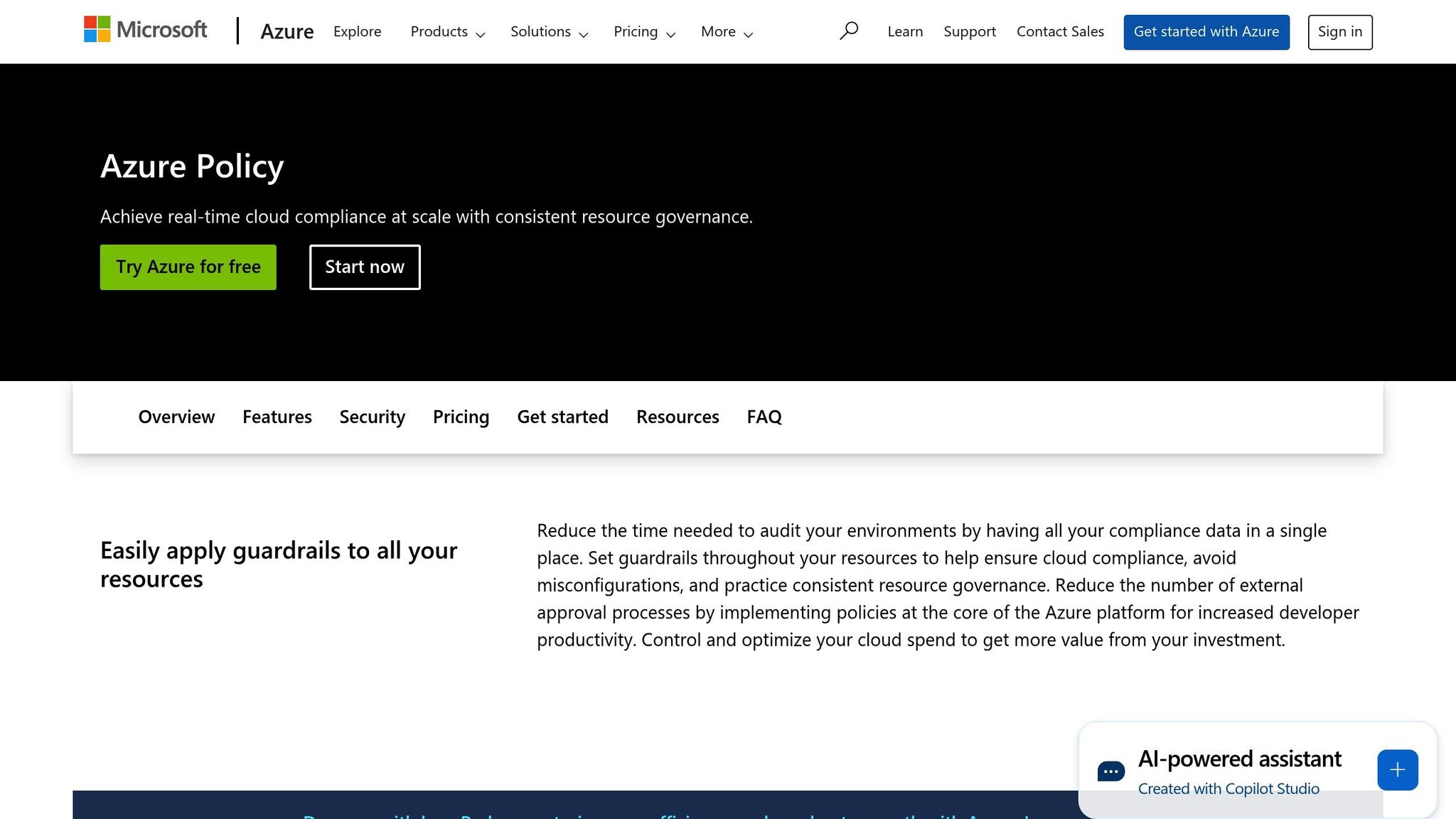Checklist: Setting Up Azure Policy for Compliance
Learn how Azure Policy simplifies compliance for UK SMBs, ensuring adherence to regulations like GDPR and automating governance tasks.

Azure Policy helps UK small and medium-sized businesses (SMBs) meet strict compliance rules like GDPR and the Data Protection Act 2018. By automating governance and enforcing rules, it ensures your cloud resources align with legal and security standards.
Why It Matters:
- Non-compliance risks: Fines up to £17.5 million or 4% of global turnover.
- Top frameworks to follow: GDPR, Cyber Essentials, PCI-DSS, and ISO 27001.
- Key benefits of Azure Policy:
- Blocks non-compliant resources.
- Automates compliance checks.
- Supports UK-specific frameworks like UK OFFICIAL and NHS standards.
- Simplifies audits with dashboards and automated reporting.
Quick Setup Checklist:
- Define compliance needs: Map regulations (e.g., GDPR) to Azure controls.
- Use built-in policies: Start with pre-defined ones for UK frameworks.
- Create custom policies: Add specific rules like tagging or encryption.
- Group policies into initiatives: Simplify management by bundling related policies.
- Enable automated remediation: Fix non-compliant resources automatically.
- Integrate with CI/CD pipelines: Ensure compliance during development.
Azure Policy saves time, reduces risks, and makes compliance easier for UK SMBs. Start with built-in policies, scale with custom rules, and monitor compliance regularly.
Regulatory Requirements for UK SMBs
Key Compliance Frameworks for UK SMBs
Small and medium-sized businesses (SMBs) in the UK that rely on cloud services face a maze of regulatory requirements, particularly around data protection and cybersecurity. Navigating these frameworks is essential not just for legal compliance but also for maintaining customer trust.
The UK-GDPR and Data Protection Act 2018 are at the heart of data protection rules for UK businesses. These laws set strict guidelines for processing and safeguarding personal data, requiring businesses to operate transparently and use appropriate technologies to protect individuals' rights.
The Network and Information Systems (NIS) Regulations 2018 focus on operators of essential services and digital service providers. They require robust security measures and mandate timely reporting of cybersecurity incidents, which directly affects how SMBs manage their cloud infrastructure.
For businesses looking to strengthen their defences against cyber threats, the Cyber Essentials scheme is a practical solution. Backed by the UK Government, it helps organisations address common online risks, reducing exposure to up to 80% of these threats. Its self-assessment approach makes it particularly appealing to SMBs.
If your business handles payment card data, the PCI-DSS (Payment Card Industry Data Security Standard) is non-negotiable. It outlines stringent rules for securing cardholder data, whether it’s being processed, transmitted, or stored. Notably, Azure is certified under PCI DSS version 4.0 at Service Provider Level 1, ensuring compliance for high transaction volumes.
For a more comprehensive approach to information security, ISO/IEC 27001 and ISO/IEC 27002 offer internationally recognised standards. These frameworks guide organisations in establishing an Information Security Management System (ISMS). Unlike Cyber Essentials, ISO 27001 certification involves third-party assessment, which can boost credibility, especially for larger businesses.
| Compliance Framework | Key Requirements | Cloud Impact |
|---|---|---|
| UK-GDPR & Data Protection Act 2018 | Transparent data processing and safeguarding rights | Requires secure and lawful data handling with appropriate technologies |
| NIS Regulations 2018 | Security measures and incident reporting | Demands strong infrastructure monitoring and threat detection systems |
| Cyber Essentials | Baseline cyber protection | Focuses on endpoint and network security |
| PCI-DSS | Cardholder data protection standards | Improves payment security and ensures encryption of sensitive data |
| ISO/IEC 27001 | Framework for ISMS | Supports comprehensive security governance |
The regulatory landscape in the UK is constantly evolving. The government is expected to introduce stricter rules, potentially adding requirements around supply chain security, incident response, and mandatory breach reporting for more sectors.
"IT compliance is no longer just about ticking boxes - it's fundamental to how businesses operate securely, responsibly, and successfully." – Creative Networks
These frameworks underpin the automated compliance tools available through Azure Policy.
How Azure Policy Helps Meet Regulatory Requirements

Azure Policy is a powerful tool that simplifies compliance for SMBs, especially those without dedicated compliance teams. It automates governance tasks, making it easier to stay aligned with stringent regulatory standards.
The platform includes built-in initiatives tailored for UK-specific frameworks, such as UK OFFICIAL and UK NHS compliance standards. These initiatives bundle predefined policies, directly addressing the controls required by these frameworks. For SMBs, this means they can implement comprehensive compliance measures with minimal effort.
One of Azure Policy’s standout features is automated compliance monitoring. It continuously scans resources in real time, flagging non-compliant elements so they can be addressed without delay.
For businesses with unique needs, Azure Policy also allows for custom policy creation. This flexibility is particularly useful for enforcing specific rules, such as mandatory resource tagging, consistent tag inheritance, restricting public storage accounts, or preventing public IP assignments on virtual machines.
Azure Policy’s ability to address multiple compliance requirements in one implementation - covering frameworks like UK-GDPR, Cyber Essentials, and PCI-DSS - streamlines the entire process. Its intuitive dashboards provide clear visibility into compliance status, highlighting which resources meet standards and which need attention. This feature is especially valuable during audits.
Step-by-Step Checklist for Setting Up Azure Policy
Once you have a solid understanding of your compliance framework, you can follow this checklist to implement Azure Policy effectively. This process is designed to break down the implementation into clear, manageable steps that even organisations without dedicated compliance teams can follow.
Define Policy Requirements
Start by identifying your regulatory obligations and linking these to specific technical controls that Azure Policy can enforce. Use tools like Azure Resource Graph Explorer to audit your Azure resources and establish a baseline. Consider your organisational structure - it's often best to create policy definitions at higher management group levels to ensure they cascade consistently across child subscriptions.
Focus first on common governance areas such as resource consistency, regulatory compliance, security controls, cost management, and operational oversight. Once your requirements are clearly defined, you can move on to assigning the relevant policies.
Assign Built-In and Custom Policies
Azure provides an extensive library of built-in policies that cater to a wide range of compliance scenarios. Begin by exploring the Azure Policy service in the portal to identify policies that align with your needs. For UK-specific compliance, look for built-in initiatives like those designed for UK OFFICIAL and UK NHS standards, which group multiple policies together for convenience.
Before applying policies in a production environment, test them in a dedicated environment, especially those with effects like modify, deploy, or deny. If the built-in policies don’t fully meet your needs, you can create custom policies using the policy definition wizard. Deploy these custom definitions at the top management group level to make them accessible across all subscriptions. Ensure each policy has a clear name and a detailed explanation of its purpose and potential impact.
"Prohibit anybody and any service from doing something: Azure Policy." - Heinrich Gantenbein, Microsoft
Set policy effects such as "Append", "Deny", "Audit", or "Disabled" for clarity. Start with audit effects to observe how policies impact your resources before enforcing stricter rules. Add custom non-compliance messages to help your team understand why certain deployments are blocked. Where appropriate, plan for automated remediation as part of your enforcement strategy.
Use Policy Initiatives for Grouped Compliance
After assigning individual policies, group them into initiatives to simplify management. Policy initiatives, also known as policy sets, allow you to bundle related policies, making it easier to manage and ensuring comprehensive compliance coverage. Even if you begin with a single policy, grouping it into an initiative allows for easier expansion later without adding complexity.
Design initiatives around compliance frameworks instead of technical categories. For example, a "UK-GDPR Compliance" initiative might include policies for data encryption, access control, and audit logging, helping you demonstrate compliance during audits. Each initiative should have a unique identifier (like a GUID), a descriptive name, and semantic versioning. Surface important parameters - especially those that affect policy behaviour - at the initiative level to allow adjustments without modifying individual policies.
Keep detailed documentation that maps initiative policies to their corresponding compliance controls. This will be invaluable during audits.
Enable Compliance Tracking and Automated Remediation
Azure Policy's compliance dashboard provides an aggregated view of your environment's compliance state, with options to drill down into specific resources and policies. Use this dashboard to monitor your most critical compliance requirements.
Automate remediation for policies using effects like deployIfNotExists or modify. In the Azure portal, go to the Policy service, select the Remediation section, and create tasks to address non-compliant resources. Use the "Create a remediation task" option to automatically correct any issues, and filter the scope of these tasks to minimise disruptions.
For policies requiring resource modifications, configure managed identities with minimal permissions, adhering to the principle of least privilege. Regularly review the compliance dashboard - weekly is a good benchmark - and evaluate remediation tasks monthly.
To streamline operations further, integrate Azure Policy into your CI/CD pipelines. This ensures consistency across environments and speeds up development processes. Keep an eye on remediation task performance and be ready to adjust policies based on operational feedback. Be mindful that some automated actions could lead to service interruptions or additional costs, so monitor closely and refine as needed.
Best Practices for Managing Azure Policy
Once you've established your Azure Policy checklist, it's important to adopt strategies that ensure compliance is maintained and scalable as your organisation grows. Managing Azure Policy effectively requires a structured approach to governance that aligns with your organisation's standards.
Centralised Policy Management
A centralised approach to policy management simplifies governance across your Azure environment. By using Azure Management Groups, you can apply policies at a higher level, allowing them to cascade down to subscriptions and resources. This eliminates the need to manage policies individually for each subscription, reducing administrative effort and ensuring consistency.
Start by creating a management group hierarchy at the root level of your tenant. From there, define policies that apply organisation-wide. For instance, you could enforce a policy that requires every resource to include a "Cost Centre" tag. By setting this rule at the top level, it automatically applies to all subscriptions underneath, ensuring uniformity across departments.
The Azure Policy Centre provides a consolidated view of compliance across your subscriptions. Use this dashboard to monitor compliance rates, identify non-compliant resources, and manage remediation tasks from one place. This centralised system streamlines audits by allowing you to generate comprehensive reports without manually checking each subscription.
Additionally, implement guardrails through Azure Policy to prevent misconfigurations. These safeguards work in the background, ensuring that new resources meet your compliance standards without requiring manual checks.
Integrate Compliance Checks into CI/CD Pipelines
To maintain continuous compliance, integrate policy checks directly into your development workflows. This approach shifts the focus from periodic audits to real-time validation throughout the DevOps lifecycle.
Use tools like Azure DevOps in combination with Infrastructure as Code solutions such as Terraform or Azure Resource Manager templates. By embedding compliance checks early in the development process, you can validate infrastructure changes against your policies before deployment. This proactive approach makes it easier to catch and fix issues early.
Storing policy definitions alongside application code in version-controlled repositories ensures automated validation and allows for collaborative review and tracking of changes. Pair this with monitoring tools that flag violations as they occur. Real-time alerts enable your team to address compliance issues immediately, keeping your environment aligned with organisational standards.
Document Policies for Audit Readiness
Clear documentation is crucial for demonstrating compliance during audits. It not only shows diligence to auditors but also provides clarity for stakeholders about the purpose and implementation of your policies.
- Assign clear and descriptive names to each policy, avoiding overly technical jargon. Use simple language that business stakeholders can understand, and include metadata (e.g., work item IDs) to link policies to specific business requirements.
- Customise non-compliance messages to provide immediate feedback when a policy blocks a resource deployment. These messages should explain what needs to change and why the policy exists, helping users understand the rationale behind it.
- Treat Azure Policy resources as code and require manual reviews for any changes to definitions, initiatives, or assignments. This ensures all modifications are reviewed thoroughly and creates a complete audit trail.
- Carefully document any policy exemptions, including the reason for the exemption and the person who approved it. Link exemptions to work items in your project management system to maintain a clear record of the business justification - an invaluable resource during audits.
Lastly, create mapping documentation that ties your Azure policies to specific compliance requirements. For example, UK organisations might map policies to GDPR or other industry regulations. This practice demonstrates thorough compliance coverage and helps identify any areas needing improvement, keeping your organisation audit-ready and aligned with regulatory standards.
Tools and Resources for Compliance Mapping
Once you've set up your Azure Policy checklist, the next step is to use the right tools and resources to maintain compliance mapping and address any gaps. Microsoft offers several tools specifically designed to help UK SMBs align Azure Policy with regulatory frameworks, making compliance implementation more straightforward.
Map UK Compliance Standards to Azure Policy
Azure Policy comes with built-in initiative definitions tailored to UK compliance requirements, such as UK OFFICIAL and UK NHS standards. These predefined policy groups consolidate controls, making it easier to ensure governance across your resources.
The Azure Policy Regulatory Compliance dashboard acts as a centralised platform for tracking your compliance status. It provides a clear overview of how well your resources align with different regulatory frameworks, helping you quickly identify and address non-compliant areas.
For organisations operating across multiple environments, Microsoft Purview Compliance Manager offers a broader governance solution. It assesses compliance risks and provides actionable steps to meet regulatory standards across your entire tech ecosystem.
| UK Compliance Standard | Azure Policy Initiative | Key Controls Covered |
|---|---|---|
| GDPR | Data Protection Baseline | Data encryption, access controls, audit logging |
| UK OFFICIAL | UK OFFICIAL Initiative | Information classification, secure configuration |
| ISO 27001 | ISO 27001:2013 Initiative | Security management, risk assessment, incident response |
| UK NHS | UK NHS Initiative | Patient data protection, clinical system security |
Another useful tool is Azure Blueprints, which allows you to create repeatable sets of Azure resources that automatically comply with your organisational standards. This is particularly handy for deploying consistent, compliant environments across multiple projects or subscriptions.
Next, it's important to evaluate the balance between using built-in policies and creating custom ones to refine your compliance approach.
Built-In vs Custom Policies: Pros and Cons
Deciding whether to rely on built-in policies or develop custom ones can have a significant impact on your compliance strategy. Built-in policies offer a quick and reliable way to meet common standards, while custom policies provide the flexibility needed for unique organisational needs.
Built-in policies are pre-tested and updated by Microsoft, ensuring alignment with widely recognised standards like CIS, PCI DSS, and ISO 27001. They reduce setup time and ongoing maintenance efforts, making them a great starting point for most organisations.
Custom policies, on the other hand, allow for tailored solutions that address specific compliance requirements not covered by standard policies. However, they require more effort to develop, test, and maintain, as this responsibility falls on your organisation.
"Choosing between built-in and custom policies is not mutually exclusive. Leverage the strengths of built-in policies for standard requirements and use custom policies to fill in gaps and address specific needs. This hybrid approach allows you to balance ease of use, comprehensiveness, and customization." - pawelhaubus, Author
| Aspect | Built-In Policies | Custom Policies |
|---|---|---|
| Development Time | Immediate implementation | Requires development and testing time |
| Maintenance | Microsoft handles updates | Organisation maintains policies |
| Customisation | Limited flexibility | Fully customisable to specific needs |
| Compliance Coverage | Covers broad, standard requirements | Addresses unique organisational needs |
| Complexity Handling | May include unnecessary rules | Handles complex, specific scenarios |
| Expertise Required | Minimal technical knowledge needed | Requires policy development skills |
A hybrid approach works best. Start by implementing built-in policies to establish a solid compliance foundation. Then, identify any gaps and create custom policies to address specific needs.
With your policies in place, the next step is to enforce them effectively through automated remediation actions.
Automated Remediation Actions
Azure Policy supports bulk remediation for existing resources and automatic remediation for new deployments. These remediation actions help fix non-compliant resources automatically, ranging from simple changes to more complex configurations.
| Remediation Type | Use Case | Impact on Compliance | Implementation Effort |
|---|---|---|---|
| Tag Application | Automatically add cost centre or department tags | Ensures resource tracking and billing compliance | Low |
| Encryption Enforcement | Enable encryption on storage accounts and databases | Meets data protection requirements (e.g., GDPR) | Medium |
| Network Security | Configure network security groups with baseline rules | Addresses security compliance frameworks | Medium |
| Backup Configuration | Automatically enable backups for critical resources | Supports business continuity requirements | High |
| Access Control | Apply role-based access control (RBAC) assignments | Enforces least privilege principles | High |
To minimise risks, start with low-impact actions like tag application before moving on to more complex configurations. Testing remediation actions in non-production environments first is essential to avoid unintended disruptions to your applications or user access.
While automation can significantly reduce manual effort, it’s crucial to consider the potential business impact of each action. Always implement proper change management processes for automated updates in production environments. This ensures smooth, continuous compliance with the mapped regulatory standards.
Key Takeaways for UK SMBs
This section wraps up the checklist's value for UK SMBs, highlighting how Azure Policy helps create a strong, scalable compliance framework that supports growth. By using this checklist, UK SMBs can leverage enterprise-level governance tools without being weighed down by the usual complexity or high costs.
The technical benefits also come with clear financial perks. Microsoft offers these compliance tools at no additional charge, eliminating the need for pricey third-party solutions. With Microsoft investing over $1 billion annually (about £800 million) in cybersecurity research and development and employing more than 3,500 security experts, UK SMBs gain access to top-tier security expertise.
"Achieve real-time cloud compliance at scale with consistent resource governance." - Microsoft Limited
UK businesses often face strict compliance requirements, and Azure provides support for over 90 compliance offerings, including G-Cloud and NHS Information Governance frameworks. This broad support allows SMBs to confidently bid for government contracts or collaborate with healthcare organisations, knowing their infrastructure is ready to meet these high standards. It also simplifies operational processes significantly.
Azure Policy streamlines compliance management by centralising data, reducing audit preparation from weeks to automated reporting. When integrated into CI/CD pipelines, developers can maintain their speed and flexibility while ensuring every deployment aligns with compliance requirements.
Automated remediation further strengthens compliance by addressing non-compliant resources in real time, preventing configuration drift.
The best approach is to start small and scale up gradually. Use built-in policies to cover common standards initially, and then introduce custom policies as your business needs grow. This method allows your team to gain experience without disrupting operations.
Compliance is an ongoing process. Use this checklist as a starting point and regularly update it to stay aligned with evolving business needs and regulatory changes.
For UK SMBs, Azure Policy transforms compliance from a challenge into a strategic advantage, enabling secure and scalable growth.
FAQs
How can Azure Policy assist UK SMBs in meeting GDPR and other compliance requirements?
Azure Policy offers UK SMBs a practical way to stay compliant with GDPR and other regulations by automating the enforcement of security policies, data encryption, and compliance controls across their cloud environments. It also ensures data residency by enabling businesses to store and process their data within UK regions, meeting GDPR's data sovereignty requirements.
On top of that, Azure Policy simplifies compliance efforts with centralised tools for monitoring and reporting. This makes it easier for SMBs to manage regulatory standards effectively while keeping their data secure.
What are the benefits of using built-in Azure Policies compared to creating custom ones?
Built-in Azure Policies come ready-made to help organisations align with widely recognised compliance standards. They’re a time-saving option for teams seeking a straightforward way to enforce standardised rules.
If your organisation has specific needs that go beyond these pre-configured options, custom policies let you create tailored governance solutions. This adaptability is especially useful for addressing unique compliance challenges.
For many small and medium-sized businesses, using a mix of built-in and custom policies strikes the right balance between simplicity and flexibility.
How can I integrate Azure Policy into CI/CD pipelines to ensure continuous compliance during development?
When working with CI/CD pipelines, integrating Azure Policy using tools like Azure DevOps allows you to implement Policy as Code. This method automates policy checks during deployments, ensuring compliance is verified at every stage. Policies are evaluated during pipeline runs, and actions like enforcement or remediation can be automated to align with organisational standards.
Embedding Azure Policy into your development process helps stop non-compliant resources from being deployed. It reduces the need for manual checks and simplifies compliance management, making your CI/CD workflows more secure and efficient.




